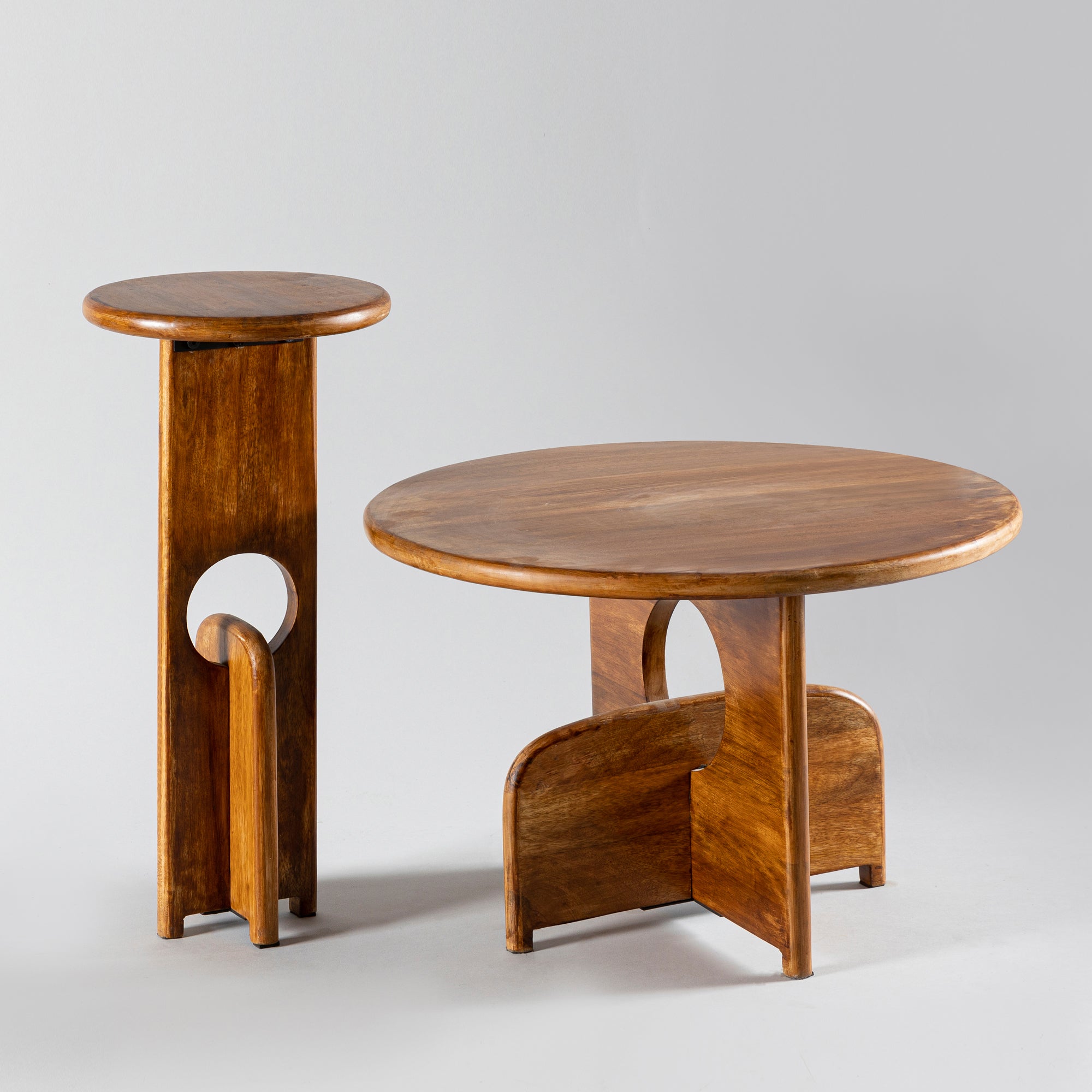Introduction
Engineered wood furniture is made from manufactured wood products, which include a range of derivative wood materials. These materials are created by binding together wood strands, fibers, or veneers with adhesives to form composite materials. Common types of engineered wood used in furniture are Medium Density Fiberboard (MDF), Particle Board, and Plywood. This type of furniture is appreciated for its cost-effectiveness, uniform appearance, and versatility. It often offers better stability and resistance to warping compared to solid wood, making it a popular choice in contemporary furniture design.
The Making of Engineered Wood Furniture
Creation of Engineered Wood: This process starts with collecting wood byproducts like sawdust, chips, and shavings. These materials are then bonded together using adhesives and heat to form sheets of engineered wood such as MDF, Particle Board, or Plywood.
Cutting and Shaping: The engineered wood sheets are cut and shaped into the desired furniture parts using advanced machinery for precision.
Finishing: These parts are then sanded to create a smooth surface. They may be coated with veneers, laminates, or paints to enhance durability and aesthetic appeal.
Assembly: The furniture pieces are assembled using joinery techniques, adhesives, and fasteners to form the final product.
Quality Check: The finished furniture undergoes quality checks to ensure stability, durability, and adherence to design specifications.
Types of Engineered Wood Used in Furniture
Medium Densityoard (MDF): Fiberb Made of fine wood fibers and glue, MDF is known for its smooth texture, making it ideal for painting.
Particle Board: Composed of wood chips and sawdust bonded together, particle board is an economical option, often used in budget furniture.
Plywood: Made of thin wood veneers glued in layers, plywood offers strength and resistance to warping, making it suitable for a variety of furniture items.
Benefits of Engineered Wood Furniture
Durability and Stability: Engineered wood, such as MDF and plywood, offers superior stability and is less susceptible to warping or splitting compared to solid wood. This makes it ideal for various climatic conditions, ensuring the longevity of furniture pieces like cabinets, shelves, and tables.
Cost-Effectiveness: One of the primary advantages of engineered wood furniture is its affordability. Being less expensive than solid wood, it provides a cost-effective solution for stylish yet budget-friendly interior design. This makes it accessible for a wider range of customers looking for economical furniture options.
Sustinability and Eco-Friendliness: Engineered wood often incorporates recycled materials, making it a more sustainable choice. The use of wood byproducts in its production means less waste and a smaller environmental footprint, aligning with eco-friendly furniture trends.
Versatility in Design and Finishes: Engineered wood offers a high degree of versatility. It can be easily coated with veneers or laminates, providing a range of aesthetic options from traditional wood finishes to modern, contemporary looks. This adaptability makes it suitable for various interior décor themes.
Consistent Quality and Appearance: Unlike solid wood, which can have natural imperfections, engineered wood provides a consistent and uniform appearance. This consistency is crucial for creating furniture with a sleek, modern aesthetic, ensuring quality control in mass-produced items.
Lightweight and Easy to Handle: Engineered wood furniture tends to be lighter than solid wood counterparts, making it easier to transport and rearrange. This is particularly beneficial for those who frequently redecorate or move.
Comparing Engineered and Solid Wood Furniture
Material Composition: Solid wood is made from entire pieces of wood, offering natural grain patterns and unique character. Engineered wood, such as MDF, Particle Board, and Plywood, is manufactured from wood fibers or particles bonded with adhesives.
Durability and Maintenance: Solid wood is known for its longevity and can be sanded or refinished multiple times. Engineered wood is less prone to warping and cracking but can be harder to repair if damaged.
Aesthetic Variety: Solid wood has a classic, authentic appeal with unique variations. Engineered wood offers a more consistent and customizable appearance, as it can be finished with various veneers or laminates.
Cost and Affordability: Solid wood typically commands a higher price due to its natural origins and craftsmanship involved. Engineered wood is more budget-friendly, making it accessible for a range of furniture styles at lower costs.
Environmental Impact: Solid wood furniture requires more wood from trees, which can raise sustainability concerns. Engineered wood, often made from recycled materials, can be seen as a more eco-friendly option.
Weight and Handling: Furniture made from solid wood tends to be heavier, which can be a factor in transport and placement. Engineered wood furniture is usually lighter, making it easier to move and handle
Maintenance and Care for Engineered Wood Furniture
Regular Dusting: Dust accumulation can scratch the surface. Using a soft, dry cloth, gently wipe the furniture. Avoid feather dusters as they can sometimes scratch the surface.
Immediate Spill Cleanup: Engineered wood is susceptible to water damage. Clean spills immediately with a dry cloth to prevent moisture from seeping into the wood and causing swelling or warping.
Avoid Excessive Moisture and Heat: Prolonged exposure to humidity can damage engineered wood. Similarly, keep it away from direct sunlight or heating vents to prevent the material from drying out and cracking.
Use Protective Mats and Coasters: To guard against scratches and moisture damage, use coasters under all drinks and place mats or trivets under hot dishes or electronic devices.
Avoid Harsh Chemicals: Clean using a slightly damp cloth with mild detergent. Avoid using all-purpose cleaners or ammonia-based products, as they can strip the finish and damage the wood.
Minor Repairs: For small scratches or chips, use a wood filler or a touch-up pen that matches the color of your furniture. This can help maintain an even and consistent finish.
Avoid Dragging Objects: When placing items on engineered wood furniture, avoid dragging them across the surface to prevent scratches.
Regular Check-Ups: Periodically check for loose fittings or hardware to ensure everything is secure.
Sustainable Aspects of Engineered Wood Furniture
Recycled Material Usage: Much engineered wood is made from recycled wood and wood waste. This process not only makes efficient use of lumber but also reduces landfill waste, making it an eco-friendlier option.
Efficient Wood Utilization: The production of engineered wood involves converting whole logs into wood fiber, ensuring minimal waste. This efficiency in using every part of the tree makes it a more sustainable choice compared to traditional solid wood, which often involves more wastage.
Reduced Impact on Forests: By relying less on solid timber, engineered wood furniture contributes to decreased deforestation rates. This preservation of natural forests is crucial for maintaining biodiversity and ecological balance.
Lower Carbon Footprint: The manufacturing process of engineered wood typically has a lower carbon footprint than that of solid wood. This is due to more energy-efficient production processes and the use of less wood overall.
Durability and Longevity: While not as long-lasting as solid wood, engineered wood furniture can still offer considerable durability, especially when well-maintained. This longevity means that it doesn't need to be replaced as frequently, reducing the demand for new materials and further contributing to sustainability.
Certification and Standards: Many engineered wood products are certified by organizations like the Forest Stewardship Council (FSC), ensuring that they come from responsibly managed forests and recycled sources.
Conclusion
In conclusion, engineered wood furniture offers a blend of affordability, durability, and versatility, making it an appealing choice for a variety of settings. Its manufacturing process emphasizes sustainability, utilizing recycled materials and efficient wood usage, thus contributing to a reduced environmental impact. With proper care and maintenance, engineered wood furniture can be a long-lasting addition to any space. By combining practical benefits with a commitment to sustainability, engineered wood furniture stands as a smart choice for eco-conscious consumers and designers.
FAQ
What is engineered wood furniture?
Engineered wood furniture is made from composite wood materials like MDF, Particle Board, or Plywood, created by binding wood fibers or particles with adhesives. It offers versatility in design and is cost-effective.
How does engineered wood compare to solid wood?
Engineered wood is more affordable and resistant to warping compared to solid wood, but it may not be as durable or repairable as solid wood.
Is engineered wood furniture durable?
Engineered wood furniture is fairly durable, especially when well-maintained, though it may not last as long as solid wood furniture.
How do I maintain my engineered wood furniture?
Maintain by regular dusting, prompt spill cleanup, avoiding excessive moisture and heat, using protective mats, and cleaning with mild detergents.
Can engineered wood furniture be sustainable?
Yes, it is often more sustainable than solid wood as it uses recycled materials, reduces waste, and has a lower environmental impact during manufacturing.

